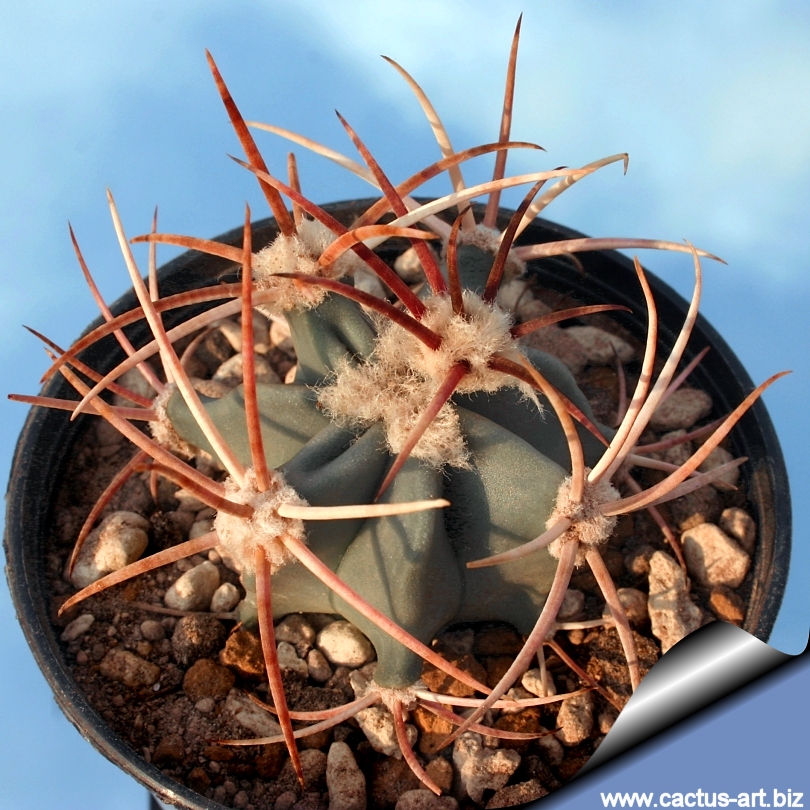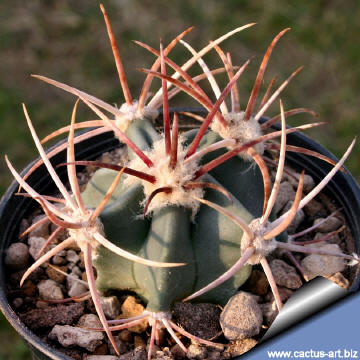|
|
|

A young Echinocactus parryi SB59 Cuidad Juarez, Chihuahua, Mexico
This species needs as much sun as possible and careful watering,
to stay compact with strong spines.
|
|

Grow it in a very draining mineral soil and
provide good ventilation (especially in winter) |
Description: Globose
depressed or shortly cylindrical, remarkably similar in morphology to
E. polycephalus but distinct by the manner of growth and
whiter spines. This Echinocactus is usually
solitary but can branches spontaneously under normal conditions.
Stem: Glabrous, greyish-green, 20 to 30 cm high and 25 to 40 cm.
in diameter (but typically under 35 cm in diameter)
Areoles: Roundish, with abundant greyish wool.
Ribs: Approx 13, acute. The
juvenile Echinocactus looks quite
different from the
mature specimens. In fact, as with other Echinocactus and Ferocactus
seedlings, the
rib structure is not yet completely apparent, and they have
pronounced
tubercles making them look superficially like
Mammillarias.
Spines: Dense, stout,
angled, and ringed, chalky white to greyish-pink that turn a darker
(redder) colouring when sprinkled with water. The spines almost
obscure the plant bodies and restrict the small
yellow flowers from opening fully.
Flowers: Yellow. They appear in summer.
Fruit: Woolly |
|
Advertising
|
|
|
|
|
|
Family:
Cactaceae (Cactus
Family)
Scientific Name:
Echinocactus parryi
Engelmann
In: Proceedings of the
American Academy of Arts and Sciences 3: 276, 1856
Conservation status: Listed in
CITES appendix 2.
Origin: Mexico
(Chihuahua)
Habitat: Grows mostly on rocky and gravely
slopes in a very dry deserts environment. The plants grow solitary or in
spreading clumps.
Synonyms:
E.
polycephalus complex:
This complex is formed by three similar barrel cacti and comprises
E. parryi,
E. polycephalus var. polycephalus, and E. polycephalus
var. xeranthemoides. The two varieties of E. polycephalus
are indeed not recognized and accepted by all taxomists, in fact studies
in the in the field, and distribution maps indicate potential sympatry
among them. While herbarium studies, field observations, scanning
electron microscopy, and genetic analysis support the distinction of
E. parryi and E. polycephalus as separate
species.
Cultivation:
Relatively difficult to grow on their own
roots as they are
root rot sensitive in cultivation,
especially after planting. Slow-growing and very
long-lived. Plants grown from seed begin to branch at nearly 20 years of
age. Hardy to -12°C, it needs full sun, and good
ventilation.
It is extremely
xerophytic and adapted to very dry soils, but plant grafted are very
easy to grow and no special skill is required. They can stay in a non
heated green house (hardy to about - 9° C for a short time). This cactus
continues to be, a
particular prize among collectors.
Propagation:
Seed or grafting. The seeds germinate with extreme
difficulty and a low rate of success. Seedlings did not do well either,
and some die each year.
|
|
|
|


|
|